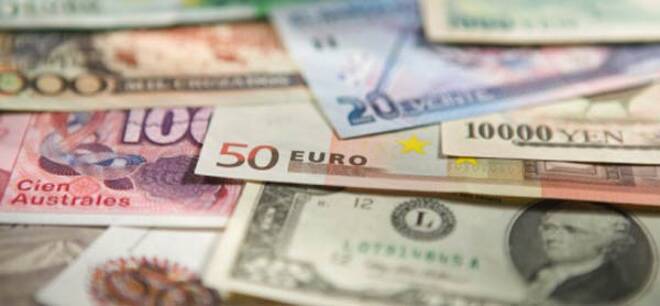Advertisement
Advertisement
EUR/USD Daily Technical Analysis for December 12, 2017
By:
Currency Markets Eye Central bank Policy Meetings
European yields declined less than U.S. yields allowing the EUR/USD to gain traction, but close off the exchange rate’s highs of the day. Norwegian CPI for November unexpectedly dipped, to a 1.0% year over year rate after 1.1% in the prior month, contrary to the median forecast for a tick higher to 1.1% year over year, which shows how week inflation expectations in Europe are. Markets are cautious ahead of central bank meetings this week. The FOMC is expected to deliver a 25-basis points hike, while ECB, BoE and SNB are all expected to stay put on Thursday, although especially ECB and BoE statements will still attract some attention after some above-forecast growth indicators.
Technicals
The EUR/USD edged higher but was unable to pierce through resistance near the 10-day moving average at 1.1832. Support is seen near an upward sloping trend line that comes in near 1.1660. Momentum has turned negative as the MACD (moving average convergence divergence) index generated a crossover sell signal. This occurs as the spread (the 12-day moving average minus the 26-day moving average) crosses below the 9-day moving average of the spread. The MACD histogram is printing in the red with a downward sloping trajectory which points to a lower exchange rate.
Central Bank Meetings Take Center Stage
Key central bank meetings and political events will drive the markets ahead of the holiday season. After May and Juncker reached a breakthrough agreement on key Brexit issues, EU heads of states are expected to officially declare that sufficient progress on divorce terms has been made to move to phase 2. That will see talks on a transition period, as well as talks on the future trade relationship between the U.K. and the EU. Finally, there is the prospect of some clarity for businesses, which have already started to prepare for a hard Brexit amid the prolonged uncertainty since the June 23, 2016 U.K. vote to leave the EU.
Political Events in German Could be Important
In Germany, there is fresh hope that new elections can be avoided after the SPD reversed its decision not to enter coalition talks. The first official meeting is scheduled for this week. Not that the start of talks guarantees that a deal can be found, especially as Merkel’s Bavarian allies are openly moving toward the right to win back AfD voters ahead of regional elections next year.
The ECB Meeting Is Likely Mapped Out
These events may overshadow Thursday’s ECB meeting to a certain extent, especially after Draghi effectively mapped out the policy path until the end of September 2018 by delivering a 9 month QE extension in October. Still, with the updated set of growth and inflation forecasts likely to show upward revisions, there is some risk of a less dovish statement than in October. Back then Draghi had to soften the blow of a EUR 30 billion reduction in monthly asset purchases from January next year, but since then data releases have overall been stronger than anticipated and the number of those calling for Draghi to commit to an end date for QE is rising. The latest surveys suggests that the majority expect a phasing out of QE over the last quarter next year, which would mean net asset purchases won’t end before December 2018 and in our view the event risk for the December 14 meeting is that the ECB will already hint that in the central scenario net asset purchases will finish with the end of the new program in September.
The Japanese BSI Increased in November
The Japanese business survey index of sentiment at large manufacturers stood at plus 9.7, up from plus 9.4 in July-September, according to the Ministry of Finance and the Economic and Social Research Institute. The buoyant mood coincides with a record economic expansion: gross domestic product climbed an annualized 2.5% in July-September for the seventh straight quarter of growth, the longest rising streak in data going back to 1994. A big contributor to growth during the quarter was capital spending. Monday’s survey shows that big manufacturers plan to raise capital spending by 10.7% in the current half of the fiscal year ending in March, up from their previous projection of an 8.9% increase.
About the Author
David Beckerauthor
David Becker focuses his attention on various consulting and portfolio management activities at Fortuity LLC, where he currently provides oversight for a multimillion-dollar portfolio consisting of commodities, debt, equities, real estate, and more.
Did you find this article useful?
Latest news and analysis
Advertisement
